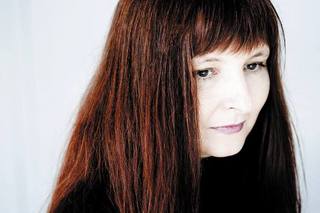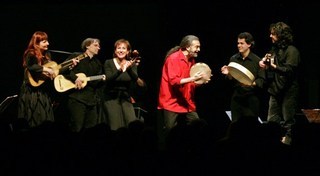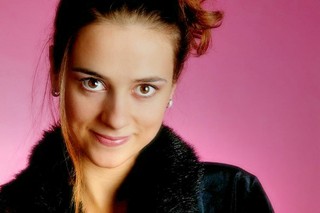|
Back
Hank Purcell and All That Jazz New York
Zankel Hall, Carnegie Hall
04/08/2015 -
Maurizio Gazzati: Ciaccona
Nicola Mattei: Improvisation La Dia Spagnola
Henry Purcell: Music for a while – The Mock Marriage: “'Twas within a furlong of Edinborough Town“ – Improvisation: “Canaria” – “A prince of glorious race descended” – The Fairy Queen: “One charming night” – Dido and Aeneas: “Ah! Belinda” – An Evening Hymn – Come, ye sons of art away: “Strike the viol” – Dido and Aeneas: “Dido’s Lament” – Ode to St. Cecilia: “Wondrous machine!” – Dioclesian: “Two in one upon a ground” – Welcome to all pleasures: “Here the deities approve” – Improvisation: “Canario” – Man is for the woman made – Timon of Athens: “Curtain tune on a Ground” – The Fairy Queen: “Oh, let me weep” (The Plaint) – Timon of Athens: “Hark! How the songsters of the grove”
Guest artists: Nuria Rial (Soprano), Vincenzo Capezzuto (Alto), Gianluigi Trovesi (Clarinet)
L’Arpeggiata: Christina Pluhar (Artistic Director/Theorbo), Doron Sherwin (Cornet à bouquin), Veronika Skuplik (Baroque violin), Eero Palviainen (Archlute, baroque guitar), Boris Schmidt (Double bass), Daniel Mayoral (Percussion), Francesco Turrisi (Piano, harpsichord, organ, melodica), Haru Kitanmika (Harpsichord and organ)

C. Pluhar (© L’Arpeggiata)
The Nightingale carols as it soars; Whereas
That carol’s a dirge in a smoky dank room;
Purcell’s songs soar too, yet married to jazz?
The glistening bride and the glowering groom
John Dryden (Attributed)
I loathe writing this review. For a year, I have savored Christina Pluhar’s ensemble, L’Arpeggiata, on YouTube. Their renderings of Monteverdi, Handel, Kircher, and the priceless Catalan music have projected this group into the forefront of iconic “ancient music” the way Kronos Quartet turned the 1980’s onto the music of our time. Such musicianship, integrity, such warmth projected by Ms. Pluhar on the theorbo and singers Rial and Philippe Jaroussky are simply iridescent.
And yes, at the three-quarter mark of their recorded concerts, the group segues into jazz, improvising their Monteverdi, taking gentle riffs with their Handel. That was delicious icing after savoring an equally tasty ice-cream cake.
Last night, though, we had an abbreviated L’Arpeggiata ensemble (seven players against the usual 10 or 12). Their program title, “Improvisations on Henry Purcell”, would be more appropriately “Quasi-Jazzy Purcell Arrangements”. But dressing Restoration English sublimated emotion into 1950’s-style pristine jazz was perhaps a misguided trick. For in the long run, enfeebling Purcell’s emotions and draining the threat from jazz makes for a rather bloodless evening.
The reason I loathe writing this is because Ms. Pluhar has summoned up some of the most startlingly good solo musicians imaginable.

L’Arpeggiata (© Helmut Lackinger)
Not only the famed guest clarinetist Gianluigi Torvesi, but drummer Daniel Mayoral, Veronika Skuplik, playing the most sensuous Baroque violin, Doron Shorwin on a Renaissance cornet (which is played recorder style) as well as a twangy Boris Schmidt on double bass and a few keyboard players.
The group didn’t bring their wonderful countertenor Philippe Jaroussky, but his replacement, Vincenzo Capezzuto (known equally for his alto voice and his brilliant dancing) gave a show-biz hooplah to his arias.

N. Rial (© www.larisonanza.it)
Nura Rial, though, was a saving grace. Or in Catholic terms, the Catalonian-born soprano was the Grace of God. On YouTube, I have religious adoration for her brilliant Catalan solos. In person, last night, hers was the voice of a young Joan Baez: pure on the top notes, intense (never growly) towards the bottom.
Not one of these singers or instrumentalists was out of step either in the semi-original Purcell arrangements or the semi-jazzy improvisations. It was all clear, the sounds blended in with pastel harmony, and the audience in Zankel Hall obviously enjoyed a relaxing, comfortable music.
Yet the demands of the evening were restricted to the musicians. The happy audience was never challenged, never asked to use their minds. They laughed when cornettist Doron Sherwin donned hipster beret and dark glasses, and applauded the talking drums, but never in this concert did one feel the tension of classical music or the surprise of jazz.
Originally, I said this was MJQ-style jazz, but it was ambiguously eclectic. The opening Purcell had a few attempts at Rock rhythms, the great lament from Dido and Aeneas faded into cafe background music (including a bar of My Funny Valentine).
Some of it worked in a quirky way. Mr. Cappezutto did a burlesque of “Man is for the woman made”, sung like Pontius Pilate’s parody in Jesus Christ Superstar and Purcell would have approved. In the only straight song, Ms. Rial gave a glorious voice to “The Plaint” from The Fairy Queen, with a frequently vibrato-less violin solo by Ms. Skuplik, and this too reached the enchantment of Restoration music at its most glorious.
Otherwise, the original Purcell melodies were turned, almost mechanically, into the chaste undangersome jazz in which nice European musicians so excel.
Mind you, I am hardly a Purcell purist. Benjamin Britten took a Purcell tune, turned it inside out, blasted it, whispered it and gave it a climax the composer could never imagine in his Young Person’s Guide to the Orchestra. A few weeks ago, Purcell’s music (or a contemporary) for Tempest was paired with the equally inspired Tempest music by Kaija Saariaho, both with 17th Century orchestration, and this pairing was a creative masterwork.
Here, though, L’Arpeggiata eschewed their usual miracles of emotional performances, exchanging 15-odd melodies which speak for themselves into vehicles that allowed the artists to have their own feasts, not celebrating Purcell but their own considerable expertise.
I speak as a minority of one, since the well-behaved full house in Zankel Hall gave enthusiastic applause to the ensemble. And the second encore actually worked. Leonard Cohen’s Hallelujah was not attached to 17th Century music (or jazz) by a long shot. Yet by playing it straight, with duets by Capezzuto and Rial, involving an apathetic audience response, the music and musicians exhibited, for the first time, a comely (to use Dryden’s word) mating of inspiration and arrangement.
Harry Rolnick
|